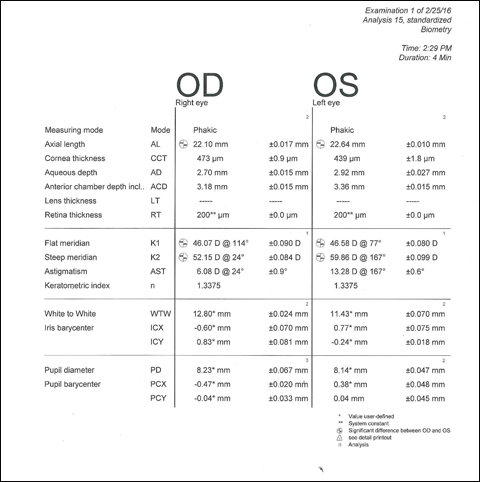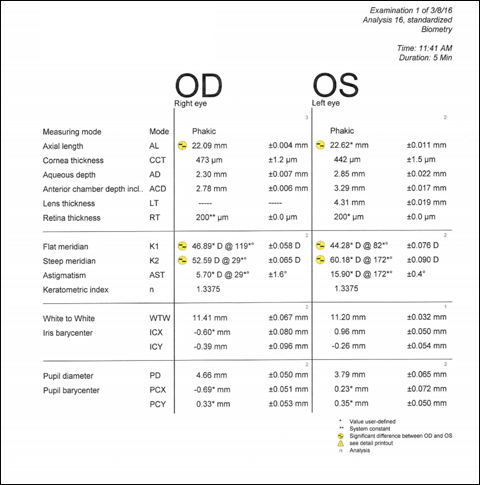Femtosecond laser, toric IOL used to treat high level of astigmatism
Quality of vision following surgery is the single most important factor that impacts patient satisfaction. Hence, the ophthalmic surgeon needs to deliver in order to meet patient expectations that have reached a new high compared with the past.
Significant corneal astigmatism can degrade quality of vision and lead to patient dissatisfaction. It is important to identify and separate lenticular astigmatism from corneal astigmatism in the preoperative workup. Further, the surgeon has to consider both anterior and posterior corneal astigmatism when calculating toric IOL power. Because total corneal astigmatism is a combination of both anterior and posterior corneal astigmatism, total corneal astigmatism cannot be fully calculated purely by evaluating anterior corneal astigmatism and the related keratometric index. Posterior corneal astigmatism can contribute to about –0.3 D. With age, anterior corneal astigmatism moves from with-the-rule to against-the-rule astigmatism, while posterior corneal astigmatism usually exhibits against-the-rule astigmatism. The evaluation of both corneal surfaces will lead to a more accurate evaluation of total corneal astigmatism.
The toric IOL addresses astigmatism and is an important and useful tool in modern day cataract surgery. Additionally, the availability of the femtosecond laser, which can create reproducible, precise corneal incisions, can have an additive effect when combined with a toric IOL, especially when dealing with high degrees of preoperative corneal astigmatism. This combination neutralizes a significant amount of preoperative corneal astigmatism and improves quality of vision to satisfy patient expectations, resulting in a happy patient.
In this column, Dr. Liang describes her technique of managing high degrees of preoperative corneal astigmatism in cataract surgery patients.
Thomas “TJ” John, MD
OSN Surgical Maneuvers Section Editor

Images: Liang E



Treating patients with high levels of astigmatism can be challenging. Diagnostic devices may give inconsistent readings, and it most likely will not be possible to completely eliminate the astigmatism. With femtosecond laser and toric lens technology, however, it is possible to reduce the astigmatism to a level at which the patient’s vision is correctable with spectacles. The key is to first rule out any extenuating major disease and then define the axis and pattern of astigmatism.
Case example
This patient is a 58-year-old male attorney who had a prior cataract and had been previously diagnosed with keratoconus and recommended for a cornea transplant. As part of the preop assessment at my center, the patient is tested before my examination, during which I can validate the results with a second round of testing.
With this particular patient, we recorded two sets of Lenstar optical biometry readings (Haag-Streit) and topography. His Lenstar results showed his astigmatism at 15.9 D with a steep axis of 172 at his initial exam (Figure 1), with the second exam resulting in 13.28 D with a steep axis of 167 (Figure 2). His topography results were not as high with his initial exam, showing a delta K of +11.17 with the steep axis at 169 (Figure 3), and his second set with a delta K of +10.52 with the steep axis at 170 (Figure 4). The Nidek OPD also captures an autorefraction. On the first set of testing, he had a sphere of –11.75 and a cylinder of 10.25 D on an axis of 167 (Figure 3), with his second test resulting in a sphere of –13.25 and a cylinder of 10.5 D on an axis of 170 (Figure 4). I did not agree with the diagnosis of keratoconus because his exam and topography showed no indication of this condition. His spectacle correction upon presentation only had about 4 D of astigmatism correction with a corrected visual acuity of 20/400. The best visual acuity we could obtain was 20/300.
The patient had been recommended for a cornea transplant; however, his cornea appeared clear without a cone on his topography. I explained the option of a toric lens along with femtosecond laser to give him the highest amount of astigmatism treatment. While I will occasionally consider refractive surgery after a toric lens and femtosecond laser treatment in some cases, with this patient’s questionable history of keratoconus and a prior corneal transplant recommendation and with his other eye being mildly hyperopic, I felt the best course of action was simply treatment with the femtosecond laser and a toric lens.
Surgical maneuvers
Using the Catalys Precision laser system (Abbott Medical Optics), I placed the limbal relaxing incisions at 9 mm and performed large paired 72° arcs at an axis of 169, an average of his topography and Lenstar steep axis readings. I prefer intraoperative aberrometry with the ORA system intraoperative wavefront aberrometry (Alcon) for all of my premium cases, but I specifically do not use the femtosecond laser for the primary or secondary incisions in this type of case because the laser wounds can exacerbate incision hydration, which may affect astigmatism readings on the aberrometry. It is best to remove incisions from the IOL calculator so the arc placement is not affected, and it is better to have paired arcs in high cylinder cases. The real-time streaming refractive data from the ORA also helps determine what residual astigmatism exists after the LRIs have been made.
The femtosecond laser is a critical tool for creating LRIs. OCT imaging allows for precise depths to be calculated, and the femtosecond laser enables perfectly placed arcs. Because these are such long arcs, there is a higher risk of perforation than if this were attempted with manual LRIs. The speed and accuracy of the system make the treatment predictable while creating precise LRIs in less than 10 seconds. This is not possible manually. Without the combination of femtosecond laser and toric IOL technology, treating these higher levels of astigmatism would not be possible.
After treatment with the femtosecond laser, I performed standard phacoemulsification. I then used the ORA’s live streaming data to verify the power, cylinder and axis placement of the IOL. For this patient, I used the ZCT600 toric lens (Tecnis, Abbott Medical Optics), and I placed it at an axis of 165 per the ORA data and preoperative calculations. Once the lens was placed, I again used the ORA to verify and optimize the lens position. In cases in which there may be movement, I will insert a capsular tension ring to lock the lens in place, although that was not necessary in this case. I then performed a routine closure.
Outcome
At day 1 postop, the patient’s vision was at 20/60 uncorrected at distance. At 1 week, he was at 20/70 uncorrected. At 1 month, he had dropped to 20/200 uncorrected, most likely due to dryness and some fluctuations that can occur as the large arcs heal. At 2 months, his vision had improved to 20/60 uncorrected, and he now corrects to 20/40 with a cylinder of +3.5 (Figure 5).

I would not perform this procedure on patients with any sort of peripheral marginal degeneration. Those cases would require a scleral pocket rather than any corneal incision because closing a corneal wound would be challenging. I have, however, performed this technique on a variety of other patients, including those with keratoconus, previous penetrating keratoplasty and previous radial keratotomy.
- References:
- Goggin M, et al. J Refract Surg. 2015;doi:10.3928/1081597X-20150122-04.
- Koch DD, et al. J Cataract Refract Surg. 2012;doi:10.1016/j.jcrs.2012.08.036.
- Nemeth G, et al Cornea. 2014;doi:10.1097/ICO.0000000000000238.
- Tonn B, et al. Invest Ophthalmol Vis Sci. 2014;doi:10.1167/iovs.14-15659.
- Ueno Y, et al. J Refract Surg. 2014;doi:10.3928/1081597X-20140218-01.
- For more information:
- Eva Liang, MD, can be reached at Center For Sight, 5871 W Craig Road, Las Vegas, NV 89130; email: eva.liang@c4slv.com.
- Edited by Thomas “TJ” John, MD, a clinical associate professor at Loyola University at Chicago and in private practice in Oak Brook, Tinley Park and Oak Lawn, Ill. He can be reached at email: tjcornea@gmail.com.
Disclosure: Liang reports she is a consultant to Abbott Medical Optics, Bausch + Lomb and Sun Pharmaceutical. John reports no relevant financial disclosures.
